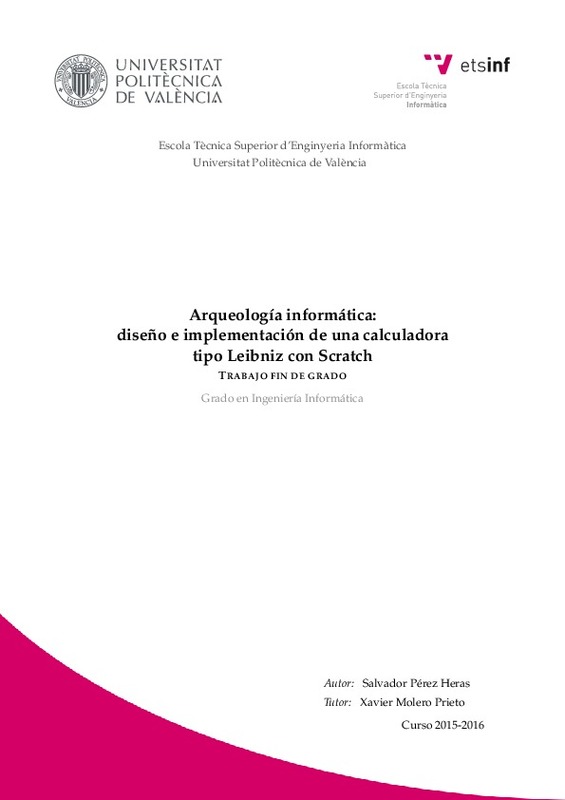|
[ES] La calculadora de Leibniz fue creada en 1673 y fue un gran avance en la época. Dicha
calculadora fue utilizada durante tres siglos por el mundo de la computación y sobretodo
por su famoso Stepped Reckoner. Su creador ...[+]
[ES] La calculadora de Leibniz fue creada en 1673 y fue un gran avance en la época. Dicha
calculadora fue utilizada durante tres siglos por el mundo de la computación y sobretodo
por su famoso Stepped Reckoner. Su creador fue el filósofo, matemático y político alemán
Gottfried Wilhelm Leibniz. Este invento fue heredado por la mayor parte de las calculadoras
mecánicas y ha sido la madre de prácticamente todos los aparatos matemáticos e
informáticos de los que podemos hacer uso hoy en día.
En este trabajo se pretende realizar un estudio histórico y un análisis de las distintas
calculadoras que ha creado el ser humano, centrándonos en la de Leibniz y en la Schubert.
A causa del gran valor histórico de las calculadoras mecánicas, este trabajo ha sido
utilizado para dar a conocer este mecanismo en la página web destinada al Museo de Informática
de la Escuela Técnica Superior de Ingeniería Informática de la UPV y contribuir
así a la difusión del patrimonio digital.
A parte, se ha realizado una aplicación en lenguaje SCRATCH del funcionamiento de
la máquina calculadora Schubert, la cual va a servir también para mostrar interactivamente
su uso a personas que no la conozcan.
[-]
[CA] La calculadora de Leibniz va ser creada a l’any 1673 i va ser un gran avanç en l’època.
Aquesta calculadora va ser utilitzada durant tres segles pel món de la computació i sobretot
pel seu famós Stepped Reckoner. ...[+]
[CA] La calculadora de Leibniz va ser creada a l’any 1673 i va ser un gran avanç en l’època.
Aquesta calculadora va ser utilitzada durant tres segles pel món de la computació i sobretot
pel seu famós Stepped Reckoner. El seu creador va ser el filòsof, matemàtic i polític
alemany Gottfried Wilhelm Leibniz. Aquest invent va ser heretat per la major part de les
calculadores mecàniques i ha sigut la mare de pràcticament tots els aparells matemàtics i
informàtics dels quals podem fer ús avui en dia.
En aquest treball es pretén realitzar un estudi històric i una anàlisi de les diferents
calculadores que ha creat l’ésser humà, centrant-nos en la de Leibniz i en la Schubert. A
causa del gran valor històric de les calculadores mecàniques, aquest treball ha sigut utilitzat
per donar a conèixer aquest mecanisme a la pàgina web destinada al Museu d’Informàtica
de l’Escola Tècnica Superior d’Enginyeria Informàtica de la UPV i contribuir
així a la difusió del patrimoni digital.
Ademés, s’ha realitzat una aplicació en llenguatge SCRATCH del funcionament de la
màquina calculadora Schubert, la qual va a servir també per mostrar interactivament el
seu ús a persones que no la coneguen.
[-]
[EN] Leibniz calculator was created in 1673 and it was a breakthrough at the time. This calculator
was used for three centuries by the computing world and especially for its famous
Stepped Reckoner. Its creator was the ...[+]
[EN] Leibniz calculator was created in 1673 and it was a breakthrough at the time. This calculator
was used for three centuries by the computing world and especially for its famous
Stepped Reckoner. Its creator was the German philosopher, mathematician and politician
Gottfried Wilhelm Leibniz. This invention was inherited by most of the mechanical calculators
and it was the mother of almost all mathematical and computing devices that
can make use today. In this work we aim to make a historical study and analysis of the different calculators
that created the human being, focusing on Leibniz and the Schubert. Because of the
great historical value of mechanical calculators, this work has been used to publicize this
mechanism on the website for the Museum of Informatics School of Engineering of the
UPV and contribute to the dissemination of the heritage digital.
Besides, it has been created an application on SCRATCH language of the performance
of Schubert calculating machine, which will also serve to show its use interactively to
people who do not know the calculator.
[-]
|







